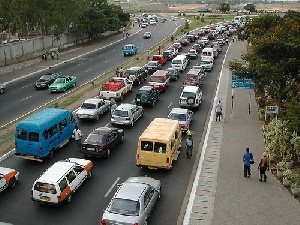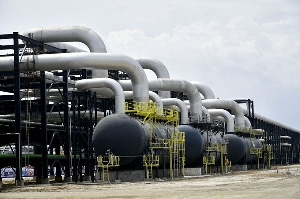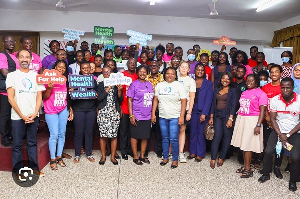Managing Traffic Congestion in Accra by overhauling the Signal Timing Procedures.
By
Dr. Robert A. Baffour
Associate Professor of Transportation Engineering and the Vice President, Ghana Telecom University College
For Most parts of Accra, vehicular traffic during the AM and the PM rush hours can be given a grade of F. It is evident from several locations that the traffic situation in Accra is bad. Without any expertise in traffic engineering or planning, one can easily conclude just by being part of the traffic stream that some of the congestion on the roads of Accra are not warranted. It appears the roadway network is woefully inadequate, the traffic control devices are completely archaic, and the driving public is mostly ignorant of traffic rules. Looking at the roadway geometry and the roadway networks in Accra, I doubt if Accra has a Travel Demand Forecasting Model that helps with the planning of the traffic situation in Accra. Accra needs a serious look at how it manages traffic and potentially look at how modern traffic management systems may be used to help solve some of the traffic situations in Ghana. The objectives of this article are: 1) to educate the driving public on some basics of signal timing, 2) explain the causes of some of the unnecessary delays in the traffic network, and 3) provide engineers and people in charge of timing the cities signals some information on the state of signal timing in practice. This article also suggests some key solutions that may help alleviate some of the traffic situation in Accra. It should be noted here that, this is by no means an exhaustive presentation of what needs to be done. It can however set the wheels in motion for what needs to be done.
Traffic congestion may be defined as having more vehicles on the road than it was designed for. For instance, if a section of road was designed to carry 2000 vehicles per hour but that section is now carrying 2001 vehicles per hour, then we say the road has exceeded it capacity and therefore congested. From this basic definition, it is evident that congestion can be temporary or can be permanent. In Accra and other parts of Ghana, a temporary congestion may occur due to such incidents as: 1) an accident on the road, 2) a stall vehicle (a common occurrence in Ghana), 3) two taxi drivers fighting, 4) a malfunctioning traffic control device such as a traffic signal (a common occurrence also), 5) the police, etc. A permanent congestion may occur when 1) the road has simply exceeded its design carrying capacity, 2) when proper traffic control devices are not used, 3) when a traffic control device is wrongly used for instance when a traffic signal is poorly timed, or 4) a terrible design flaw such as the termination of a four lane traffic to a two lane traffic such as the condition at Mallam from Kasoa to Kaneshie. As it may be obvious to most motorists on Accra roads, there are several factors that contribute to the woes in the traffic stream especially as they pertain to congestion. Most of the causes cited above for both the temporary and permanent congestion may be taken as special projects if our cities are to enjoy smooth sail of traffic. The focus of this article however is on how to reduce traffic congestion in Accra and other parts of the country using proper and modern signal timing procedures.
Most traffic intersections are controlled by a traffic control device such as a stop sign, yield signs and in most cases where the volume is high by a traffic signal commonly referred to as traffic light. Traffic signals are designed and timed to regulate the flow of traffic at the local intersection. Local traffic intersections are part of the entire traffic network that move people and goods from A to B in the city. It is very easy to note that delays at local intersections are easily propagated to the adjoining intersections. This is commonly referred to as the “shock wave effect” of traffic noise. It is important therefore that traffic signals are timed very well to make sure they move the volume that they are suppose to move. In the science of traffic signal timing, the amount of green time generally allocated to a movement (referred to as a phase) depends on the relative volume associated to that movement. Similarly, the amount of yellow time given depends on the speed of the road. When these basic conditions are not satisfied, a signal may produce the adverse effect. Traffic signal timing in Accra seems to suffer from old and inaccurate data. It appears 2000 intersection volumes are controlling 2010 traffic needs. For proper signal controls, traffic counts needs to be updated often to account for the increase in traffic volumes.
A general observation of the traffic signal timing system in Ghana suggest that there is the need to overhaul the entire timing process to maximize the usefulness of these traffic control devices to better serve the driving public. A driver in a queue waiting for the green to come on is expected to clear the intersection when the green is released and times out. Whenever the green changes and the allocated green fails to clear the queue, the potential for bottleneck is very high. Such situations are recipes for all kinds of traffic problems including unnecessary accidents and delays. A typical cause of this condition is when the signal timings are based on some historical data that needs to be revisited. The fact that one hardly sees traffic counters (manual or electronic) on the streets suggests that traffic timing may be based on legacy data that may not be realistic. Green times are very short for some movements and there are even some principal roads where the yellow intervals are set at two seconds. Such timings do not work anymore and they all help make the signal timing cycle very inefficient. Following are a few observations and potential solutions to resolve some of these problems.
1. Fixed time controllers vs. Actuated controllers. It can safely be assumed that most of the traffic signals in Accra and many parts of the country are operating on a fixed time plan. Fixed time controllers provide timing plans that give green to a movement whether there is a car waiting or not. In modern traffic signal timing, fixed time controllers are becoming obsolete. Signal timing nowadays uses actuated or semi-actuated controllers where timings are driven by demand. Detectors whether positioned on the ground or are side seeing cameras can detect the presence of a vehicle and signal the intersection controller to give the required green upon demand. This way, green will not be given to minor road that does not have any volume while traffic on the major roads get delayed unnecessarily. If a fixed time controller will be used, then there should be a constant update of the intersection turning movement volumes.
2. Allowing Right turn on red. The era where right turns on red were not permitted is gone. To be able to move volumes and especially in Accra where we do not have many dedicated right turn lanes, it is crucial that right turn on red are permitted especially when the sight distance does not pose any problems. There are several instances in Accra where there are no conflicts in the traffic movement during a particular signal phase but motorist are not permitted to turn right on red. A complete review of our traffic intersections is needed to make right turn on red part of the overlapping movements to help release some of the unnecessary congestion on our streets.
3. Using only actuated pedestrian signals. That is, the green light should always be given to the driving public until a pedestrian physically call for the green by punching a button. Even a single vehicle waiting one second for a turn because the signal is pointing to a pedestrian who does not exist is time lost to humanity. Pedestrian should call for green only when they need one.
4. Avoiding unnecessary protected left turns. The use of green and red ARROWS is very tricky in signal timing. They have to be used with care otherwise they may produce unintended results. Several of our signals that have red arrows are not being used effectively. Green arrows used for left turn movements are used to make sure left turners are protected. They are called protected left turn movements. They are used mostly in locations where sight distances are a problem especially on curve. For any intersection where the left turn volume is not heavy, a left turn storage bay is just provided to store the left turn movers and hope that gaps will be presented to allow them to make their left turns when the trough movements are moving. If left turn protection is needed, a left turn arrow is provided BUT it is very important that left turns may be allowed to go when there is adequate gap from oncoming vehicles. In such instances, the signal bulb is reverted to a solid green when the through movement is released. This helps reduce the green time for the left turn movement allowing other movements to have more green. This is called PROTECTED/PERMITTED. There are several intersections in Accra where a protected left turn phase (a green arrow) followed by a red arrow may not be warranted. Red arrow means one cannot go even when there are gaps and no conflicting movements.
5. The police. There are several location in the city where the police presence is not needed. Most of the locations where the barriers are set tend to cause unnecessary traffic. I always wonder why the police set their barriers so close to the toll gates when motorist are trying to readjust themselves from a five lane toll gate to a two lane road only to find out that one of the two lanes is closed about 50 feet from the toll gate. If the barrier is needed, it should be sited far away from the toll gate. Temporary Police barriers mounted in the evenings tend to affect the intersections in the neighborhood. While we see the need for these night check points, their locations and the mounting times need a complete review. Any second a vehicle sits in traffic due to delay is a waste to mankind and a danger to the environment as well.
6. Use of Solar Traffic Signals. An average Ghanaian driver especially a taxi or trotro driver does not understand the simplest driving logic that the first person to come to the intersection gets to go first if it is not controlled by a device. That is the situation when the traffic signal is down. It is said that ECG sometimes sends voltage in excess of 240V, sometimes as high as 300V to the traffic bulbs. This is not surprising as we see these voltage fluctuations in our homes. This is perhaps one of the reasons why most of the traffic lights in Accra have dead bulbs. Ghana needs a better way of supplying reliable energy to the traffic signals and perhaps solar may be one of the solutions. Currently, South Africa is deploying over 2000 solar traffic signals in Johannesburg. Is there any reason why we cannot do Solar.
7. Intersection with manual controls. Ghana may be one of the few places in the world where traffic control is left in the hands of people on the street. Even though I see the value of these people sometimes, there are several times that their presence may be dangerous to the people they are helping especially when they get a call to collect money. If that is the way to go, these boys need to be trained and be provided with uniforms.
8. Conclusion. The objective of this paper as stated earlier was to educate the public on some signal timing issues and also to get the attention of stakeholders in the signal timing business of some existing timing procedures being used elsewhere. I hope the discussions presented above do just that. A comprehensive review of the traffic timings in the cities especially Accra is needed. Also constant traffic counts are needed to get accurate and realistic intersection turning movements and link volumes to support a better traffic signal timing regime.
Opinions of Thursday, 21 October 2010
Columnist: Baffour, Robert A.



















